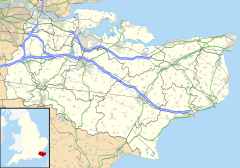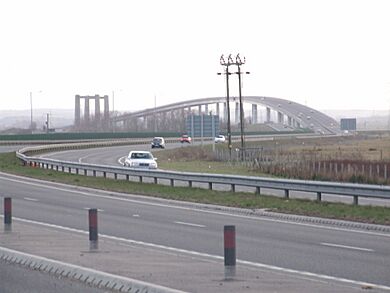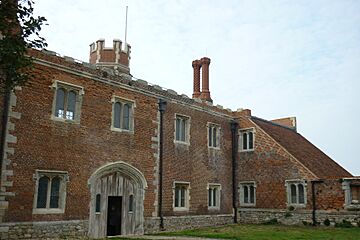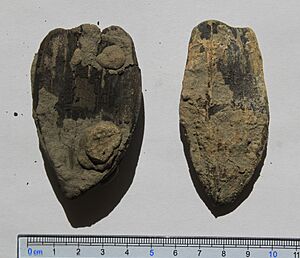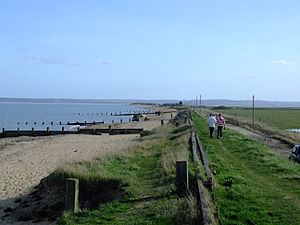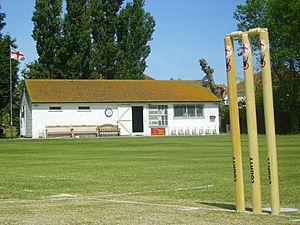Isle of Sheppey facts for kids
Quick facts for kids Isle of Sheppey |
|
|---|---|
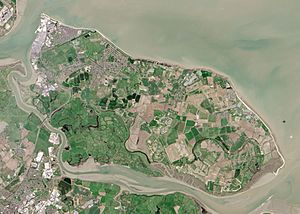 Sheppey as seen by the Operational Land Imager on the satellite Landsat 8 |
|
| Area | 93 km2 (36 sq mi) |
| Population | 40,300 (2011 Census) |
| • Density | 433/km2 (1,120/sq mi) |
| OS grid reference | TQ970695 |
| District | |
| Shire county | |
| Region | |
| Country | England |
| Sovereign state | United Kingdom |
| Post town | Sheerness |
| Postcode district | ME11/ME12 |
| Dialling code | 01795 |
| Police | Kent |
| Fire | Kent |
| Ambulance | South East Coast |
| EU Parliament | South East England |
| UK Parliament |
|
The Isle of Sheppey is an island located off the northern coast of Kent, England. It is near the Thames Estuary, about 42 miles (68 km) from central London. The island covers an area of 36 square miles (93 square kilometers). It is part of the Borough of Swale local government area. The name Sheppey comes from an old English word, Sceapig, which means "Sheep Island".
Long ago, what we now call Sheppey was actually a group of islands. These included Sheppey itself, the Isle of Harty to the southeast, and the Isle of Elmley to the southwest. Over time, the waterways between these islands filled up with mud and sand. This created one large island. Today, two bridges connect Sheppey to the mainland of Kent.
Sheppey, like much of northern Kent, is mostly made of a type of clay called London Clay. This clay is a great source of fossils. The highest point on the island is The Mount, near Minster. It rises to about 250 feet (76 meters) above sea level. The rest of Sheppey is low-lying. The southern part of the island has marshy land with many small waterways. This area is mostly used for grazing animals. The island's economy relies on a dockyard, a port, three prisons, and many caravan holiday parks.
Contents
- The Swale: Sheppey's Watery Border
- Sheppey's Past: A Look Back
- Maritime History: Sheppey and the Sea
- Natural History: Sheppey's Wildlife and Fossils
- Early Aviation: Sheppey's Flying Firsts
- Sheppey Today: Life on the Island
- Education on Sheppey
- Sport and Leisure Activities
- Local Media and News
- Airport Ideas for Sheppey
- See also
The Swale: Sheppey's Watery Border
Sheppey is separated from the mainland by a channel called the Swale. In ancient times, ships sometimes used this channel. It helped them travel to and from ports like Chatham and London. Using the Swale meant they could avoid bad weather in the Thames Estuary or North Sea.
Connecting Sheppey: The Bridges

The first Kingsferry Bridge was built in 1860. This meant people no longer needed ferries to cross to the mainland. Over time, four different bridges have been built across the Swale at this spot. All these bridges had to be high enough for ships to pass underneath, heading to the commercial docks at Ridham.
- 1860: The London, Chatham and Dover Railway built the first bridge. It had a central part that could be raised between two towers. Both trains and road traffic used it.
- 1906: The South Eastern and Chatham Railway replaced the first bridge. This new one had a "rolling lift" design. It was first operated by hand, then later by electricity.
- 1959: The current Kingsferry Bridge was installed. This is a lifting bridge that can raise both the road and the railway line. This allows ships to pass below.
- 2006: The Sheppey Crossing was finished and opened on July 3. This is a four-lane road bridge. It rises to 95 feet (29 meters) above the Swale. It carries the A249 main road. People walking, cycling, or with animals, as well as the railway, still use the lifting Kingsferry Bridge. This bridge offers the most direct route between the island and the Iwade/Lower Halstow area.
On September 5, 2013, thick fog caused a large accident on the Sheppey Crossing bridge. About 130 vehicles were involved. Eight people were seriously hurt, and 30 others went to the hospital.
Old Ways to Cross: Ferries
In the past, four ferries connected the island to mainland Kent. These included the King's Ferry to Iwade and the Harty Ferry to Faversham. There was also a ferry from Elmley and a passenger ferry to the Port Victoria railway station on the Grain Peninsula. The Harty Ferry was the last one to operate, stopping at the start of the First World War.
Sheppey's Past: A Look Back
Archaeologists have found signs of early human activity on the island. This includes ancient enclosures at Kingsborough Manor from the Neolithic (New Stone Age) and Bronze Age. Later signs of Roman and medieval life have also been found.
Viking Raids and Winter Camps
In the year 835, Viking invaders attacked Sheppey. This was the first major Viking raid known in Southern England. Sheppey continued to suffer from more raids. Its coastal monasteries were easy targets for the Danes.
In 855, Sheppey became a winter camp for a Viking army. These were likely the same raiders from earlier attacks. The Vikings continued their raids in the spring. They used Sheppey's churches as places to feast or as their main bases.
In 1016, Cnut the Great of Denmark and his forces reportedly went to the Isle of Sheppey for the winter. This was to avoid fighting King Edmund Ironside. King Edmund gathered his army and attacked Cnut shortly after Easter.
Shurland Hall: A Historic Home
Shurland Hall, near Eastchurch, is named after its first owners, the De Shurland family. In 1188, Adam de Shurland owned a mill and over 1,000 acres (400 ha) of land, mostly marsh.
Sir Robert de Shurland (died 1324) was a famous member of the family. He fought in wars against Scotland. He was knighted during the siege of Caerlaverock in 1300. A strange legend surrounds Sir Robert. It says he killed a priest and went to the king for a pardon. He rode his horse into the sea to reach the king's ship and got forgiveness. On his way back, an old woman told him that the horse that saved him would cause his death. To defy this, Sir Robert killed his horse. Later, he kicked the horse's bones, and a sharp piece pierced his foot. He got an infection and died. This story is similar to old tales from other countries. It became very popular after being published in 1837 by Richard Barham.
Shurland Hall remained with the Cheyne family until the 1500s. During the First World War, soldiers stayed at the Great Hall, and it was badly damaged. Today, Shurland Hall is a Grade II listed building. This means it is an important historic building. In 2006, money was given to restore the hall's front. The restoration work was finished in 2011.
Dutch Occupation of 1667
Sheppey is one of the few parts of the United Kingdom that was temporarily taken over by a foreign power since William the Conqueror's invasion in 1066. This happened in June 1667. A Dutch fleet sailed up the Thames Estuary towards the Medway River. They captured the fort at Sheerness. The fort was not fully built, and the soldiers were not well-fed or paid. So, they did not fight hard against the strong Dutch Navy. The Dutch quickly took over the whole island for several days before leaving. Before they left, the Dutch took supplies, weapons, and guns. Then, they burned everything that could burn.
King James II's Capture (1688)
James II tried to escape England in December 1688. This was during a time when William of Orange was taking over the throne. James II chose the Swale channel as his escape route.
He landed at Elmley on a small boat. Local fishermen surrounded him. They thought he was a hated Jesuit priest and took his money, watch, and coronation ring. Eventually, one of them recognized him. The group then took him to Faversham, where he was held.
Bluetown Heritage Centre: Island History
Bluetown is home to the history and Heritage Centre for the Isle of Sheppey. The Heritage Centre has many items and displays about Sheppey's past. These include exhibits on aviation, sea history, wartime activities, and general island history. The center also offers guided walks of Sheppey Isle and Bluetown.
The current Heritage Centre building has a long history. It was first called the "New Inn." In 1868, it became "The Royal Oxford Music Hall." The next year, it became the Criterion Public House, with a music hall behind it. In 1879, a new brick building replaced the old one.
On June 5, 1917, the Criterion was badly damaged by a German air raid. You can still see marks from the attack on the dockyard wall nearby. After the air raid, the building was rebuilt. It kept some of its original features. After being used for many other things, it became the Heritage Centre in January 2009.
Maritime History: Sheppey and the Sea
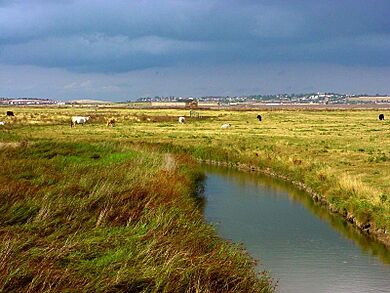
King Henry VIII needed the River Medway as a safe place for his navy. So, he ordered a small fort to be built at the river's mouth in 1545. This was Garrison Fort.
Sheerness is a commercial port and the main town on the Isle of Sheppey. Its history is closely linked to its past as a Royal Naval dockyard town. Samuel Pepys helped set up the Royal Navy Dockyard in the 1600s. Sheerness was attacked by the Dutch Navy in June 1667. Seventy-two Dutch ships forced the small fort to surrender. They landed troops who occupied the town for a short time.
The dockyard served the Royal Navy until 1960. Since then, it has become one of the largest and fastest-growing ports in the UK. The Port of Sheerness has an old building called the Old Boat House. Built in 1866, it was the first multi-story iron-framed industrial building in the UK.
A large ferry terminal was built at Queenborough Pier in 1876. It offered a nightly service to Flushing (Vlissingen) in the Netherlands. These services stopped during the First World War. The terminal was used for military traffic. The small port closed in the 1930s. A passenger, car, and lorry ferry service operated from 1974 to 1994.
Today, the dockyard and port at Sheerness are very important to Sheppey's economy. They handle a lot of car imports and exports. The island also has a large steel works. However, the island is facing economic challenges, and these industries are not as big as they once were.
The area just outside the dockyard was settled by dockyard workers. They built wooden houses and painted them with blue paint taken from the dockyard. This area was, and still is, known as Blue Town. It is now mostly taken up by the Sheerness Steel complex.
Beyond Blue Town, another residential area overlooking the sea was built for government officials. This area became known as Mile Town because it is one mile (1.6 km) from Sheerness.
About 200 shipwrecks have been recorded around Sheppey's coast. The most famous is the SS Richard Montgomery. This ship was loaded with bombs and explosives. It got stuck on sandbanks during the Second World War. As of 2004, there were discussions about how to deal with the threat from the Montgomery. These ideas included covering the ship in concrete or removing the bombs. No final decision has been made. New research in 2005–06 suggested the danger had passed. Constant monitoring should keep the local community safe.
Natural History: Sheppey's Wildlife and Fossils
In 1629, the first recorded visit by botanists (plant scientists) to the island took place. They were arrested and imprisoned in Queenborough Castle because people thought they were foreigners. They were later released.
Edward Jacob (1710–1788) bought a small manor on the Isle of Sheppey in 1752. There, he enjoyed his hobby as a naturalist. He found many interesting things for people who study old objects, nature, geology, and animals. In 1777, Jacob published a book about his fossil finds, including what he called "the remains of an elephant."
The island has a population of scorpions. The Euscorpius flavicaudis scorpion has lived there since the 1860s. It is thought they arrived on a ship. They have adapted well to the climate. They save energy and only move for food and to reproduce.
In 2008, scientists published details about a fossil skull found on the island. It belonged to a large flying bird from the Eocene epoch called Dasornis. This fossil was found in the London Clay deposits.
Early Aviation: Sheppey's Flying Firsts
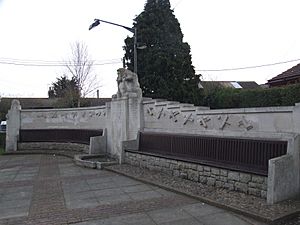
The island has a long history of aviation development in England. It was home to Lord Brabazon's Royal Aero Club. This club started in Leysdown in the early 1900s to promote ballooning. The club quickly became interested in airplanes. In July 1909, the Short Brothers set up Shellbeach Aerodrome on nearby marshland. It was built to house six Wright Flyers. The next year, they moved a few kilometers to Eastchurch. A new, more suitable aerodrome had been built there for the club.
The Eastchurch airfield played a big part in British aviation history from 1909. That's when Frank McClean bought Stonepits Farm and turned it into an airfield for members of the Aero Club of Great Britain.
The Short brothers, Horace, Eustace, and Oswald, built aircraft in Battersea to be tested at the site. Later, famous aviators like Moore-Brabazon, Professor Huntington, Charles S. Rolls, and Cecil Grace all visited and used the flying club. Wilbur Wright and his brother Orville came to the Isle of Sheppey to see the new flying grounds of the Aero Club. In 1909, Moore-Brabazon made the first flight with live cargo in a fixed-wing aircraft. He tied a waste-paper basket to a wing of his Shorts-built Wright aircraft. He used it as a "cargo hold" and airlifted one small pig!
In July 2009, Eastchurch celebrated 100 years of aviation history on the island. An event called SkySheppey brought together many groups and visitors. They recognized the important role Eastchurch played in British aviation history.
Since March 2015, a new museum, The Aviation Museum Eastchurch, has been set up. It is located at The Old Mill Green near HMP Standford Hill. It remembers the early aviators and the site's long history as an RAF Station from World War I to the end of World War II.
Sheppey Today: Life on the Island
The largest town on the island is Minster, with a population of 21,319. Other towns include Sheerness and Leysdown-on-Sea. The entire north coast is covered with caravan parks and holiday homes. The Royal Society for the Protection of Birds (RSPB) managed part of the Elmley National Nature Reserve until 2013. Now, the Elmley Conservation Trust manages it.
There are three prisons on the island, all located south of the village of Eastchurch. These are HMP Elmley, HMP Standford Hill, and HMP Swaleside. Together, they hold about 2,800 inmates.
In the 2011 census, the island had 40,300 residents. Many of them travel to the mainland for work. They use the Sheerness-Sittingbourne rail link and the new Sheppey Crossing Bridge.
Education on Sheppey
Secondary education (for older students) on the island is provided by Oasis Academy Isle of Sheppey. The school moved into new buildings in February 2013. It is split between two sites: East and West. The academy is divided into five smaller "mini-schools."
Further education (after secondary school) is available at EKC Sheppey College.
There are also several primary schools (for younger children) on the island.
Sport and Leisure Activities
The island has a non-league football club called Sheppey United F.C.. They play at Holm Park.
The island's biggest cricket club is Minster Cricket Club. They play in the Kent Cricket League. Sheppey Cricket Club plays in the Kent Regional Cricket League.
Sheppey also has a rugby union club, Sheppey RFC.
The Isle of Sheppey Sailing Club (formerly Sheppey Yacht Club) organizes the Round the Isle of Sheppey Race. This race started in 1959. The club also holds other races for different types of boats.
Local Media and News
Local news and television programs for Sheppey are provided by BBC South East and ITV Meridian. Television signals come from the Bluebell Hill TV transmitter.
The island is served by county-wide radio stations. These include BBC Radio Kent on 96.7 FM, Heart South on 102.8 FM, and Gold on 603 AM.
Three radio stations broadcast from Sheppey itself. BRFM 95.6 FM broadcasts 24 hours a day from studios on the Minster Cliffs. Sheppey FM 92.2 is a community radio station based in the Heritage Pavilion, Sheerness. Hospital Radio Swale broadcasts from the Sheppey Community Hospital in Minster.
The Sheerness Times Guardian is the island's local weekly newspaper.
Airport Ideas for Sheppey
Since the 1940s, different ideas for a Thames Estuary Airport have been suggested. Two of these ideas involved building an airport on an artificial island northeast of the Isle of Sheppey. The most recent idea was in 2008. It was supported by the then Mayor of London, Boris Johnson. He thought an artificial island off Sheppey could be a good alternative to building a new runway at Heathrow.
See also
 In Spanish: Isla de Sheppey para niños
In Spanish: Isla de Sheppey para niños
- Sheppey Light Railway
- Islands in the River Thames


